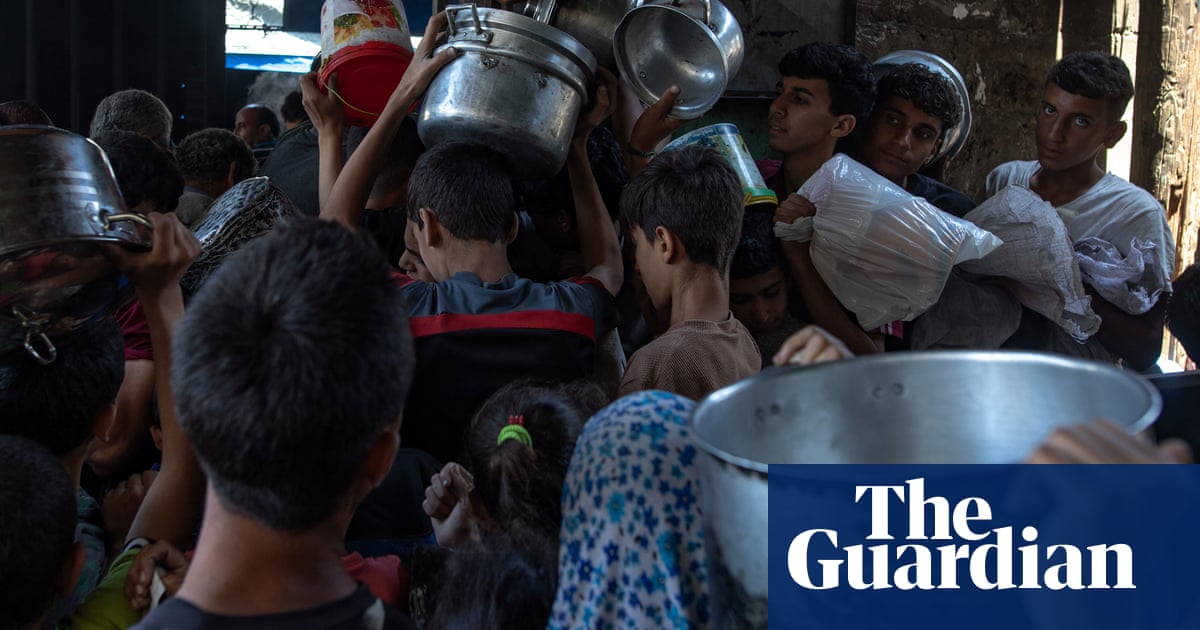Twenty-nine children and elderly people have died from starvation in Gaza in the last two days, the Palestinian Authority health minister has said , as Israeli strikes killed at least 52 people since dawn amid a renewed military offensive across the territory.
The warning came as food aid is expected to start reaching Palestinians inGazathis week after Israel began allowing limited goods through after nearly three months after global pressure to lift the blockade and halt a newly expanded offensive.
Jens Laerke, a spokesperson for the UN humanitarian agency OCHA, said on Thursday about 90 trucks, out of almost 200, carrying medicine, wheat flour and nutrition supplies, had entered Gaza. Laerke said aid groups were facing significant challenges distributing the aid because of insecurity, the risk of looting and coordination issues with Israeli authorities.
However, the Palestinian Red Crescent said on Thursday that Palestinians in Gaza had yet to receive aid deliveries that had crossed over the border and that sending so few trucks was an “invitation for killing” because of the risk of mobbing.
“I can prove that nobody has received [aid]. No civilian has received anything yet. In fact, say most of these trucks are still in Kerem Shalom at the border, inspected, but not into Gaza,” Younis al-Khatib, the president of the Palestine Red Crescent society, told reporters.
“It’s very hard to hide the rush or the looting that will happen,” he added.
Malnutrition is spreading in Gaza, medics and aid workers in the devastated Palestinian territory have warned for months, with aid distribution being hindered by displacement, bakeries operated by the UN World Food Programme shut due to a lack of cooking gas, and soaring prices for the limited amount of food available in shops and markets.
“In the last couple of days we lost 29 children,” the West Bank-based Palestinian Authority health minister, Majed Abu Ramadan, told reporters, describing them as “starvation-related deaths”. He later clarified that the total included elderly people as well as children.
The Palestinian Authority has partial control over the West Bank, which has been occupied by Israel since 1967, but Hamas has ruled the Gaza Strip since 2007.
Earlier this month,the IPC estimatedthat nearly 71,000 children under the age of five are expected to be “acutely malnourished”, with 14,100 cases expected to be severe over the next 11 months.
Israel imposed the blockade on all supplies in March, saying Hamas was seizing deliveries for its fighters – a charge the group denies. Earlier this month, a global hunger monitor said that half a million people in the Gaza Strip face starvation.
Abu Ramadan, who was mayor of Gaza City from 2005 to 2008, said that only seven or eight hospitals out of Gaza’s 36 were partially functioning, and that more than 90% of medical stocks were now at zero due to the blockade.
“My information is that very few shipments went inside Gaza – 90 to 100 truckloads and in the south and mid zones.” Asked if there were any medical supplies among them, he said: “As far as I know … it’s only flour for bakeries.”
UN agencies have said that the amount of aid entering Gaza falls far short of what is required to ease the crisis.
Umm Talal al-Masri, 53, a displaced Palestinian in Gaza City, described the situation as “unbearable”.
Hossam Abu Aida, 38, said: “I am tormented for my children.” He told AFP: “For them, I fear hunger and disease more than I do Israeli bombardment.”
AFP footage showed bags of recently delivered flour at a bakery in the central city of Deir el-Balah, where workers and a host of machines began kneading, shaping, baking and packaging stack after stack of pita bread.
The UN humanitarian aid organisation for children, Unicef, says more than 9,000 children have been treated for malnutrition in Gaza this year, and food security experts say tens of thousands of cases are expected in the coming year.
Experts also warn the territory could plunge into famine if Israel does not stop its military campaign and fully lift its blockade, but the World Health Organization said last week that people are already starving.
New data shared with the Guardian by the US-based Project Hope, which focuses on healthcare, one of the few humanitarian organisations still operating health clinics in Gaza, ‘‘found that malnutrition among children, pregnant and lactating women has surged amid the almost three-month aid blockade, with some clinics reporting up to 42% of pregnant women and 34% of lactating mothers being diagnosed as malnourished”.
“Children are also increasingly affected,” according to a statement from Hope. “Our teams on the ground report that more and more families are relying on our clinics for nutritional supplements and that children visiting Project Hope clinics have gone for weeks only consuming high-energy biscuits and ready-to-use therapeutic food – items given to malnourished patients for short-term survival needs, rather than sustained nourishment.”
Ghadeer, a nurse with Project Hope in Gaza, said: “The number of malnutrition cases has skyrocketed. Two months ago, malnutrition cases did not exceed 50 cases per day. Now, we’re seeing about 200 cases per day. Many of the children we see haven’t eaten real food in weeks – only the nutritional biscuits we distribute. They’re losing weight, becoming withdrawn, and getting sick more easily. We are doing everything we can, but we’re seeing the consequences of extreme hunger in an entire generation. Without more food and aid coming in, I fear for their future.”
Meanwhile, plumes of smoke rose Thursday over the northern Gaza Strip where Israel’s military urged civilians to evacuate, as rescuers said Israeli strikes across the territory killed more than 50 people.
Gaza’s civil defence agency said there had been “52 martyrs and dozens injured as a result of airstrikes carried out by the occupation” across the territory.
The intensified Israeli offensive has drawn criticism, with EU foreign ministers agreeing on Tuesday to review the bloc’s cooperation accord with Israel.
